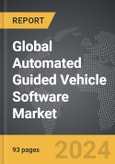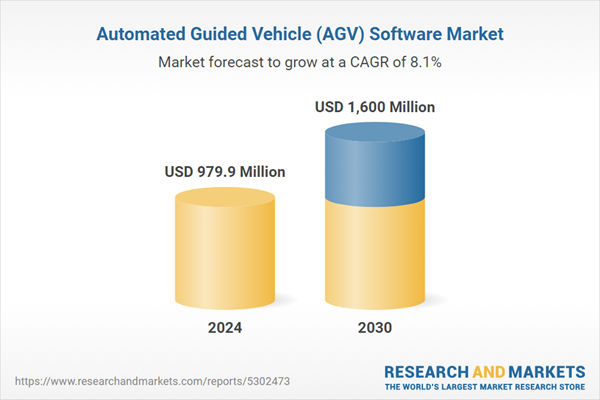The global market for Automated Guided Vehicle (AGV) Software was valued at US$979.9 Million in 2024 and is projected to reach US$1.6 Billion by 2030, growing at a CAGR of 8.1% from 2024 to 2030. This comprehensive report provides an in-depth analysis of market trends, drivers, and forecasts, helping you make informed business decisions. The report includes the most recent global tariff developments and how they impact the Automated Guided Vehicle (AGV) Software market.
Segments: Type (In-built, Integrated); End-Use (Automotive, Manufacturing, Food & Beverage, Aerospace, Healthcare, Logistics, Other End-Uses).
Geographic Regions/Countries: World; United States; Canada; Japan; China; Europe (France; Germany; Italy; United Kingdom; and Rest of Europe); Asia-Pacific; Rest of World.
The analysts continuously track trade developments worldwide, drawing insights from leading global economists and over 200 industry and policy institutions, including think tanks, trade organizations, and national economic advisory bodies. This intelligence is integrated into forecasting models to provide timely, data-driven analysis of emerging risks and opportunities.
Global Automated Guided Vehicle (AGV) Software Market - Key Trends and Drivers Summarized
What Is Automated Guided Vehicle (AGV) Software and How Does It Operate?
Automated Guided Vehicle (AGV) software is a sophisticated digital platform that controls the movement, navigation, and coordination of AGVs in various environments, from warehouses and manufacturing plants to distribution centers and ports. These software systems are designed to manage a fleet of AGVs, enabling them to transport goods efficiently and autonomously across designated paths or free-roaming zones within a facility. AGV software typically incorporates several core functionalities, including path planning, collision avoidance, load management, and real-time tracking, ensuring that vehicles move safely and efficiently around other equipment and personnel. With advanced AGV software, logistics managers can monitor vehicle status, optimize routes based on live data, and schedule tasks for AGVs, all from a centralized interface. Additionally, some AGV software integrates with Warehouse Management Systems (WMS) and Manufacturing Execution Systems (MES), allowing seamless coordination between AGV operations and broader facility workflows. By automating material handling and transportation processes, AGV software not only reduces labor costs and human error but also significantly boosts productivity and operational efficiency across a variety of industrial applications.What Technological Advancements Have Fueled the Development of AGV Software?
The development of AGV software has been driven by advancements in several key technologies, including artificial intelligence (AI), machine learning, sensor fusion, and the Internet of Things (IoT), all of which work together to create a more intelligent and adaptive system for vehicle management. Early AGV systems relied on fixed paths marked by physical guides like wires or magnets, which limited flexibility and required significant infrastructure investment. Modern AGV software, however, uses AI-powered navigation algorithms and machine learning to enable free-roaming capabilities, allowing AGVs to operate without fixed paths and adapt to dynamic environments. Sensor fusion combines inputs from various sensors, such as lidar, cameras, and ultrasonic sensors, enabling AGVs to detect and react to obstacles in real time, navigate complex spaces, and avoid collisions. IoT integration further enhances AGV software by enabling connectivity with other smart devices within the facility, allowing for coordinated operations and data sharing across multiple systems. This allows AGV fleets to work in unison with robotic arms, conveyors, and other automated equipment, creating a seamless flow of materials within a facility. These technological advancements have made AGV software more scalable, flexible, and efficient, transforming it into an essential tool for facilities seeking to enhance automation and improve workflow adaptability in an increasingly competitive industrial landscape.Where Are Automated Guided Vehicle Software Solutions Making the Biggest Impact?
Automated Guided Vehicle software has significantly impacted industries like warehousing, manufacturing, and logistics, where the demand for speed, precision, and operational efficiency is paramount. In warehousing, AGV software enables autonomous vehicles to handle repetitive material movement tasks, from picking and packing to loading and unloading, freeing human workers to focus on more complex, value-added tasks. E-commerce giants, in particular, rely on AGV software to keep up with high-order volumes and fast delivery requirements, making AGVs indispensable for reducing order fulfillment times. In manufacturing, AGV software coordinates material flow between workstations, transporting raw materials and parts to the assembly line and finished products to storage or shipping areas. This capability has become especially important in sectors like automotive, electronics, and pharmaceuticals, where precision and just-in-time (JIT) production methods are critical. Logistics hubs and distribution centers also benefit from AGV software by using AGVs for pallet handling, cross-docking, and trailer loading, which streamlines operations and reduces human involvement in potentially hazardous tasks. The impact of AGV software extends beyond operational efficiency; by enabling a seamless flow of goods and optimizing inventory management, it supports lean manufacturing and warehousing practices, ultimately leading to reduced costs, shorter lead times, and higher customer satisfaction.What Are the Key Growth Drivers in the Automated Guided Vehicle Software Market?
The growth in the Automated Guided Vehicle Software market is driven by a convergence of factors, including technological advancements, labor shortages, and the growing demand for efficient, automated material handling solutions. One of the primary drivers is the rapid advancement in AI and machine learning, which has made AGV software more adaptable, reliable, and capable of handling complex environments and tasks. This has broadened the appeal of AGV solutions across various sectors, enabling companies to implement AGVs without needing fixed pathways, which reduces setup costs and increases operational flexibility. The ongoing labor shortage, particularly in logistics and manufacturing, is another significant growth driver, as companies seek automated solutions to fill gaps left by reduced human labor. With AGV software, organizations can maintain high productivity levels with fewer personnel, making AGVs a cost-effective and reliable alternative to manual labor. Another key factor is the rising e-commerce demand, which has intensified the need for fast and scalable warehousing solutions. AGV software allows companies to scale their material handling processes efficiently, meeting the increased order fulfillment demands driven by online shopping trends. The integration of AGV software with other automation systems, such as Warehouse Management Systems (WMS) and Enterprise Resource Planning (ERP) systems, also enhances its value by enabling a fully interconnected and responsive logistics environment. Finally, as sustainability becomes a priority, AGV software supports energy-efficient operations, as these vehicles can be programmed for optimal route planning and low-energy consumption, making them environmentally friendly. These combined factors underscore the rapid adoption and investment in AGV software, as businesses across industries recognize the competitive advantages of automating their material handling processes with intelligent, data-driven solutions.Report Scope
The report analyzes the Automated Guided Vehicle (AGV) Software market, presented in terms of units. The analysis covers the key segments and geographic regions outlined below.Segments: Type (In-built, Integrated); End-Use (Automotive, Manufacturing, Food & Beverage, Aerospace, Healthcare, Logistics, Other End-Uses).
Geographic Regions/Countries: World; United States; Canada; Japan; China; Europe (France; Germany; Italy; United Kingdom; and Rest of Europe); Asia-Pacific; Rest of World.
Key Insights:
- Market Growth: Understand the significant growth trajectory of the In-built segment, which is expected to reach US$1.2 Billion by 2030 with a CAGR of a 8.8%. The Integrated segment is also set to grow at 6.0% CAGR over the analysis period.
- Regional Analysis: Gain insights into the U.S. market, valued at $273.8 Million in 2024, and China, forecasted to grow at an impressive 7.4% CAGR to reach $238.2 Million by 2030. Discover growth trends in other key regions, including Japan, Canada, Germany, and the Asia-Pacific.
Why You Should Buy This Report:
- Detailed Market Analysis: Access a thorough analysis of the Global Automated Guided Vehicle (AGV) Software Market, covering all major geographic regions and market segments.
- Competitive Insights: Get an overview of the competitive landscape, including the market presence of major players across different geographies.
- Future Trends and Drivers: Understand the key trends and drivers shaping the future of the Global Automated Guided Vehicle (AGV) Software Market.
- Actionable Insights: Benefit from actionable insights that can help you identify new revenue opportunities and make strategic business decisions.
Key Questions Answered:
- How is the Global Automated Guided Vehicle (AGV) Software Market expected to evolve by 2030?
- What are the main drivers and restraints affecting the market?
- Which market segments will grow the most over the forecast period?
- How will market shares for different regions and segments change by 2030?
- Who are the leading players in the market, and what are their prospects?
Report Features:
- Comprehensive Market Data: Independent analysis of annual sales and market forecasts in US$ Million from 2024 to 2030.
- In-Depth Regional Analysis: Detailed insights into key markets, including the U.S., China, Japan, Canada, Europe, Asia-Pacific, Latin America, Middle East, and Africa.
- Company Profiles: Coverage of players such as Addverb Technologies, Agv International, America In Motion, Daifuku, Danbach Robot Jiangxi and more.
- Complimentary Updates: Receive free report updates for one year to keep you informed of the latest market developments.
Some of the 37 companies featured in this Automated Guided Vehicle (AGV) Software market report include:
- Addverb Technologies
- Agv International
- America In Motion
- Daifuku
- Danbach Robot Jiangxi
- E&K Automation
- Eca
- Echkart
- Grenzebach
- Hyster-Yale Materials Handling
Tariff Impact Analysis: Key Insights for 2025
Global tariff negotiations across 180+ countries are reshaping supply chains, costs, and competitiveness. This report reflects the latest developments as of April 2025 and incorporates forward-looking insights into the market outlook.The analysts continuously track trade developments worldwide, drawing insights from leading global economists and over 200 industry and policy institutions, including think tanks, trade organizations, and national economic advisory bodies. This intelligence is integrated into forecasting models to provide timely, data-driven analysis of emerging risks and opportunities.
What’s Included in This Edition:
- Tariff-adjusted market forecasts by region and segment
- Analysis of cost and supply chain implications by sourcing and trade exposure
- Strategic insights into geographic shifts
Buyers receive a free July 2025 update with:
- Finalized tariff impacts and new trade agreement effects
- Updated projections reflecting global sourcing and cost shifts
- Expanded country-specific coverage across the industry
Table of Contents
I. METHODOLOGYII. EXECUTIVE SUMMARY2. FOCUS ON SELECT PLAYERSIII. MARKET ANALYSISIV. COMPETITION
1. MARKET OVERVIEW
3. MARKET TRENDS & DRIVERS
4. GLOBAL MARKET PERSPECTIVE
UNITED STATES
CANADA
JAPAN
CHINA
EUROPE
FRANCE
GERMANY
ITALY
UNITED KINGDOM
REST OF EUROPE
ASIA-PACIFIC
REST OF WORLD
Companies Mentioned (Partial List)
A selection of companies mentioned in this report includes, but is not limited to:
- Addverb Technologies
- Agv International
- America In Motion
- Daifuku
- Danbach Robot Jiangxi
- E&K Automation
- Eca
- Echkart
- Grenzebach
- Hyster-Yale Materials Handling
Table Information
| Report Attribute | Details |
|---|---|
| No. of Pages | 93 |
| Published | April 2025 |
| Forecast Period | 2024 - 2030 |
| Estimated Market Value ( USD | $ 979.9 Million |
| Forecasted Market Value ( USD | $ 1600 Million |
| Compound Annual Growth Rate | 8.1% |
| Regions Covered | Global |









